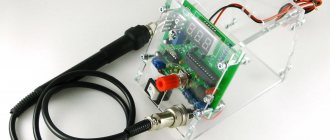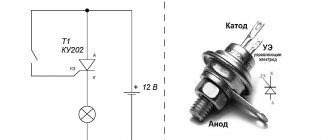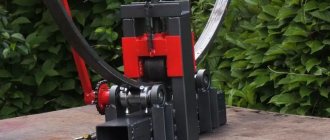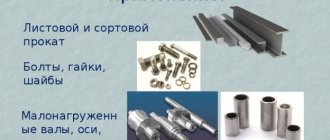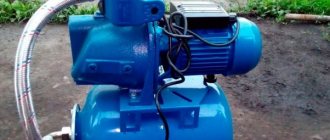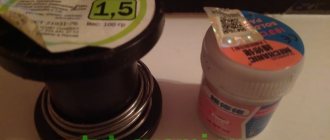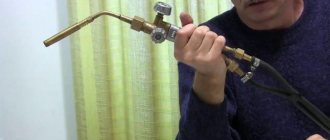In the life of every home craftsman, a situation may arise when a particular problem can be solved most effectively only with the help of soldering equipment. It is necessary to choose this device correctly, because you want the purchased equipment to help satisfy your need without any complications.
Everyone understands that without knowledge of the technical characteristics of soldering equipment it is extremely difficult to choose the most suitable option among the variety of such devices.
It is important to remember that the quality of soldering depends not only on the design of the soldering iron, but also on the features of the components supplied with it, which in the most budget model are represented by a control module and a spring holder.
This soldering device is best suited to meet household needs. It will be able to maintain the required temperature during operation for efficient operations, and will also protect against overloads and static.
If you compare a soldering device in a similar configuration with a standard special-purpose soldering station, you will find out that in terms of additional equipment, both of these devices are no different. The latter is usually supplied with thermal tweezers , a local heating hair dryer, a heat emitter, vacuum tweezers and auxiliary fittings.
Classification of soldering devices
The soldering station allows you to perform highly specialized tasks, so it is more preferable. These devices can be classified depending on the purpose of use. They are the ones who determine the complete set of a particular model. There are several types of soldering devices:
- Thermal air. A device that comes with a hair dryer and allows you to perform hot air soldering.
- Induction. A small device, which, despite this, has quite a large working potential and endurance.
- Pulse. Designed for installation and dismantling of modern circuits.
- Infrared. The most suitable type of device for repairing a mobile phone or tablet at home.
Bottom line
Soldering stations have long replaced conventional soldering irons in professional workshops. Infrared devices are especially often used in such tasks. The availability of hot air devices makes them attractive for beginning radio amateurs.
They are more functional and easier to use than classic soldering irons, and their higher cost is more than compensated by their numerous advantages. A good soldering station is the key to high-quality and reliable repairs.
Technological application features
Based on characteristics such as the type of soldering, these devices can be divided into two main groups - lead and lead-free.
Lead stations
The design of devices intended for lead soldering includes a special module that allows you to select the desired level of tip heating. They can be made in two versions - using electricity for operation and in the form of induction-type stations.
Speaking about induction stations, it should be noted that the ability to use these devices to perform the necessary manipulations is provided by an alternating magnetic field.
During operation, each soldering element is processed with individually selected power, which is done automatically. This capability is built into the device itself by the manufacturer; it can determine the heat capacity of the soldering component without user intervention.
Induction soldering stations are more convenient to use and have a high level of heat transfer.
Lead-free stations
If you need to solder small circuit elements or hard-to-reach components, then use the non-contact soldering method. Hot air and infrared soldering stations operate on this principle.
The operation of infrared soldering equipment is carried out by using the properties of infrared rays produced by ceramic or quartz elements. Infrared stations are used mainly for mounting and dismantling elements of computer circuits and motherboards.
The operation of hot air stations is based on the principle of point transfer of hot air. Thanks to this, they can effortlessly heat up hard-to-reach elements without touching adjacent contacts.
Most often, workers in workshops for repairing household electronic and mobile equipment use this type of soldering device.
Types of heating elements of soldering irons
Electronic technology is constantly being improved and in one microcircuit you can count millions of parts, for example, transistors. The improvement of these elements makes it impossible to use traditional mounting schemes; the reason for this is that the parts are located very tightly on the board.
Heating elements of soldering irons
That is why soldering stations, which are more suitable for working with boards, have become widespread.
Hot air gun soldering station
As already noted, most stations are designed for assembling boards, that is, you can solder any part with their help, but unsoldering it is quite difficult.
To solve this problem, a device called a hot air gun is used. It allows you to perform work using hot air.
Infrared heater
They are used in a large number of devices, ranging from simple heaters to various technological equipment that use local heating.
In particular, heaters of this type have found their application in the operation of soldering devices for working with printed circuit boards.
Operation of various types of soldering equipment
Due to the variety of types of soldering equipment, choosing a soldering device that best suits the tasks at hand can be difficult. When planning to purchase this or that model, we advise you to first study their technical capabilities and the scope of application recommended by the manufacturer.
Home craftsmen who have to perform small operations with a soldering iron often find themselves in a situation where the sensitive elements of the device overheat, but they cannot do anything about it due to the inability to correctly adjust the temperature of the working tip .
Those who encounter this quite often should definitely consider purchasing a soldering station with a hair dryer instead of a regular soldering iron.
Such stations are supplied with a power supply, which allows you to customize the voltage and temperature of the device at your discretion.
However, you should not expect that after purchasing a soldering station with a thermal stabilization system you will be able to provide yourself with comfortable working conditions. Before choosing a specific model, it is necessary to compare all offered stations according to such characteristics as power. Craftsmen who plan to use refractory solders especially need to worry about this.
If this point is not paid attention to, the following negative consequences may occur during operation of such a station:
- due to exceeding the permissible soldering temperature, the circuit components will begin to overheat;
- due to severe overheating, the service life of the soldering iron tip will be significantly reduced;
- the durability of the heating element will be sharply reduced;
- constant overheating of tracks on the board;
- poor soldering quality.
If such situations occur quite often, then you should think about replacing the equipment you are using with special devices for lead-free soldering. Not only do they have a higher power rating , but they can also be used for lead soldering.
TOP products
Before purchasing, be sure to familiarize yourself with the TOP best models of soldering irons for amateurs and professionals.
Best hot air soldering station
Zhongdi ZD-8907 - the best hot-air model
Among electronics lovers, Zhongdi Station ZD-8907 is especially popular. This is a fairly popular model that is of good quality and durability. With careful use, ZD-8907 will serve a person for decades.
One of the main advantages of this soldering iron is its compactness. It does not take up much space on the table, making it very convenient to work with. The power of the device is 300 W. This allows you to use it to repair any electronics.
The best two-channel soldering station
People who want to purchase a two-channel soldering iron should pay attention to the Element 937D. This is a universal tool that allows you to work with both large electronics and small microcircuits. Among the advantages of this model is its heating accuracy. The error is only 8-10 degrees, which is very small.
Additional Information! The Element 937D is equipped with an excellent ceramic heater. This allows you to use the device for high-quality repairs of the smallest parts.
Best Ceramic Soldering Station
Bison 55334 is one of the highest quality ceramic soldering irons.
Among the best devices with a ceramic heater is the Bison 55334. This is a budget model that is available to every electronics lover. The device is universal and suitable for both amateurs and professionals.
The device is equipped with a small screen that displays the heating temperature. Bison 55334 heats up to 550 °C, the error is 10 degrees. Because of this, some radio amateurs rarely use it to repair sensitive elements.
Best Induction Soldering Station
The best induction device is considered to be Quicko 202. This soldering iron is suitable for high-quality soldering and desoldering of microcircuits. The device is equipped with a temperature regulator and a special system that protects against overvoltage and overheating.
Quicko 202 is ideal for working with sensitive elements, as its temperature error is only two degrees. The main disadvantage of a soldering iron is its high cost.
Best digital soldering station
If you need a digital station, you need to pay attention to Yihua 992D. This model differs from other soldering irons in its temperature stability and almost instantaneous heating. The station body is made of high quality plastic.
The device is equipped with a built-in computer and a small display that displays temperature information.
Methods of controlling soldering devices
Bearing in mind that soldering stations are most often used in the manufacture and repair of electronics and that not only professionals, but also amateurs are interested in them, manufacturers decided to create a new type of device for them that has broader functionality and combines the capabilities of different types of equipment.
One of the features of such devices is that several modules can be connected to them, turning them into devices for performing contact or non-contact soldering, as well as performing other operations thanks to the supplied set of nozzles and tips.
When considering different models of soldering equipment, you need to pay special attention to the way the station is controlled. Depending on this, two types of devices can be distinguished - digital and analog.
When using analog-type devices, it is imperative that a technician be constantly present next to them, since when a certain temperature is reached, the device must be turned off, otherwise it will lead to overheating of the soldering tip.
At the same time, the temperature of the de-energized device begins to decrease and to resume soldering you will have to wait some time until the temperature rises again to operating temperature.
In digital stations, work is supported by special software that monitors the heating temperature of the tip and adjusts it if necessary.
It follows from this that it is best to choose devices with a digital control mode for soldering, because in this case the master can count on a more stable and accurate level of maintaining the required temperature.
From the history of soldering and metallurgy
Soldering is widely used in industry and everyday life. Thus, in the mechanical engineering field it is used in the production of turbine blades, disks, pipeline systems and many other products. Soldering is used in the production of electronic equipment for various purposes.
Soldering electronic equipment
The advantages of this technological process include the following:
- Low temperature heating of connected parts. this allows you to preserve the structure and mechanical parameters of the materials.
- This method allows you to ensure the mechanical cleanliness of the seam and this allows you to avoid additional mechanical processing.
- Modern soldering methods make it possible to connect parts made of steel alloys, non-ferrous metals, etc.
Soldering is one of the oldest methods of metal processing. Its use helped solve many problems in the manufacture of dishes, weapons, jewelry, etc.
Several thousand years ago, soldering was already widely used by artisans. Thus, during excavations on the territory of Babylon, gold items were discovered, in which individual parts were soldered. And on the site of ancient Rome, lead pipes were found that were part of the water supply system and assembled using tin-lead solder. Moreover, some researchers are convinced that the legendary Monomakh hat, kept in the Kremlin, is assembled from several thousand elements made of gold and connected by soldering.
Arc welding
Before the advent of electric arc welding, soldering was used along with welding performed in a forge to create permanent connections between metal parts. In principle, we can say that the advent of electric welding significantly stopped the development of soldering and its transformation into a technical process for joining metal parts.
Brazing Technology
But the emergence and rapid development of aviation construction, astronautics, and microelectronics has led to the emergence of a high and stable demand for the use of this method of assembling parts. In particular, soldering is used to create complex components in mechanical engineering and the construction of various devices. In some cases, soldering turned out to be the only way to connect parts.
Principles for choosing soldering devices
Modern soldering equipment is designed to perform high-quality connections between elements. And in order for it to cope with this task most effectively, when choosing it, it is necessary to pay attention to the following design and technical features:
- Type of heating element. Today, you can buy two types of soldering devices in stores, depending on the type of heater used in them - ceramic and nichrome. Ceramic heaters require a minimum of heating time, however, they are unstable to uneven heating and can crack. However, if the soldering equipment is equipped with a thermal stabilization system, then such heaters can demonstrate good heat transfer, high power and durability. Compared to them, nichrome heaters do not have such a long service life, so they should be chosen if you plan to use the soldering device infrequently. The main advantage of nichrome heaters is their lower price compared to ceramic ones.
- Range of adjustable temperature conditions.
- Warm-up speed.
- Power. To ensure high-quality operation of soldering equipment, it is necessary to take into account the purpose of its use. More specifically, you need to consider the type of soldering that needs to be done, as well as the components that will be worked with. Based on this, it becomes clear that it is the power that you need to pay attention to first when choosing a station. This should be especially remembered by those buyers who choose equipment for repairing sensitive types of equipment - navigators, tablets, etc.
- Voltage.
- Ergonomic parameters - shape, size and weight.
And also, one should not ignore objective factors that can help in choosing a suitable soldering device:
- Based on current international standards, all work related to the manufacture and repair of electronics must be carried out using lead-free soldering. Therefore, in the selected equipment, the maximum temperature regime should not exceed 250 degrees Celsius.
- Arrangement of microcircuits in a BGA package. At first glance, it may seem that this makes some sense, because this way you can reduce the dimensions of the product. But at the same time, a negative point arises - soldering becomes a more labor-intensive operation due to the inaccessibility of components.
Short review
Let's start with a station with a Quick 203H digital control unit (its photo is shown in the figure below).
Appearance of the QUICK 203Н station
The original model of this station costs between $220-$240, a Chinese analogue can be found at half the price (when choosing, pay attention to the package, it can be supplied without a soldering iron). Works great with SMD radio components and lead-containing solder.
Read also: Beige manicure with stripes
Video: review and operation in real conditions of the QUICK 203Н station
Negative points: massive elements and lead-free solder require a long time to warm up.
Characteristics:
- The power declared by the manufacturer is 90W.
- Operating temperature from 200C° to 420C°.
- A voltage of 36V with a frequency of 400kHz is supplied to the induction coil.
- Stabilization of the established thermal regime is carried out with an error of 2C°.
- Heating to an operating temperature of 350C° takes no more than 25 seconds.
The digital control unit allows you to set 10 temperature profiles, set a power-on password lock, perform calibration, and set a delay time for turning on the sleep mode and turning off the device.
Those who purchased a Chinese analogue of the device are advised to immediately worry about purchasing the original tip, since what is included in the kit is more decorative than working.
Now let's look at the PS-900 station operating using SmartHeat® technology (its appearance is shown in Figure 3). This is the most affordable model from the OKI line, its estimated cost is about $250.
Characteristics:
- Minimum power 5W, maximum – 60W (automatically adjusted).
- The inductor operates at a frequency of 470 kHz.
- Power consumption – 90W.
- Supply voltage from 90 to 240V.
Peculiarities:
- Since the temperature regime is set by a cartridge nozzle, the control unit panel is simplified to the minimum; it only has a power button.
- It is possible to replace the standard inductor with a diameter of 7.5 mm with a less powerful five-millimeter one of 35 W. This makes it possible to perform delicate soldering using microtips.
- The soldering iron automatically turns on when removed from the stand and turns off when installed back.
- It is necessary to separately purchase a set of cartridge tips for various soldering modes.
As a comparison, we present the main characteristics of one of the top-level models - MX-5241 (see Figure 6). It is necessary to immediately warn that in the hands of an amateur such an instrument will become an expensive toy, nothing more.
Figure 6. MX-5241 – equipment for professionals
Characteristics:
- Output power range from 5 to 80W (automatically adjusted).
- The operating frequency of the inductor is 13.56 MHz.
- Power consumption – 125W.
- Supply voltage from 90 to 240V.
Two independent channels allow you to simultaneously use thermal tweezers and a soldering iron.
Thanks to the instantaneous power indicator, selecting the required tip cartridge is greatly simplified.
The cost of this “miracle tool” is more than $1200.
